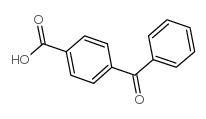4-(Phenylcarbonyl)benzoic Acid

4-(Phenylcarbonyl)benzoic Acid structure
|
Common Name | 4-(Phenylcarbonyl)benzoic Acid | ||
|---|---|---|---|---|
| CAS Number | 611-95-0 | Molecular Weight | 226.22700 | |
| Density | N/A | Boiling Point | 415.7ºC at 760 mmHg | |
| Molecular Formula | C14H10O3 | Melting Point | 198-200 °C(lit.) | |
| MSDS | Chinese USA | Flash Point | 219.3ºC | |
|
Identification and characterization of novel benzil (diphenylethane-1,2-dione) analogues as inhibitors of mammalian carboxylesterases.
J. Med. Chem. 48 , 2906-15, (2005) Carboxylesterases (CE) are ubiquitous enzymes responsible for the metabolism of xenobiotics. Because the structural and amino acid homology among esterases of different classes, the identification of selective inhibitors of these proteins has proved problemat... |
|
|
Photosensitizing and Inhibitory Effects of Ozonated Dissolved Organic Matter on Triplet-Induced Contaminant Transformation.
Environ. Sci. Technol. 49 , 8541-9, (2015) Dissolved organic matter (DOM) is both a promoter and an inhibitor of triplet-induced organic contaminant oxidation. This dual role was systematically investigated through photochemical experiments with three types of DOM of terrestrial and aquatic origins th... |
|
|
An improved method for the production of antibodies to lipophilic carboxylic hapten using small amount of hapten-carrier conjugate.
J. Immunol. Methods 220 , 105-114, (1998) A rapid, simple and low cost procedure for preparing minute amount of hapten-protein conjugates was developed using 4-acetyl benzoic acid (ABA) and two other closely related small chromophoric haptens. The amide bond-generating mixed anhydride method of Erlan... |
|
|
Effects of photochemically immobilized polymer coatings on protein adsorption, cell adhesion, and the foreign body reaction to silicone rubber.
J. Biomed. Mater. Res. 44(3) , 298-307, (1999) Photochemical immobilization technology was utilized to covalently couple polymers to silicone rubber either at multiple points along a polymer backbone or at the endpoint of an amphiphilic chain. The coating variants then were tested in vitro and in vivo for... |
|
|
Brain pyridoxal kinase: photoaffinity labeling of the substrate-binding site.
J. Biol. Chem. 264(8) , 4318-21, (1989) 4-Benzoylbenzoic acid inhibits pyridoxal kinase activity competitively with respect to pyridoxal. The Ki was determined to be 5 x 10(-5) M. Binding studies showed that 4-benzoylbenzoic acid bound to pyridoxal kinase at a 1:1 molar ratio and with a dissociatio... |
|
|
Photochemically immobilized polymer coatings: effects on protein adsorption, cell adhesion, and leukocyte activation.
J. Biomater. Sci. Polym. Ed. 10(10) , 1063-74, (1999) Amphiphilic chains of 4-benzoylbenzoic acid moieties and polymer were photochemically immobilized onto silicone rubber to ask whether the covalently coupled polymers would passivate the silicone rubber by inhibiting protein adsorption and subsequent cell adhe... |
|
|
Antibodies to cyclosporine A (CsA) by a novel route and their use to monitor cyclosporine levels by radioimmunoassay (RIA).
J. Immunol. Methods 118(2) , 257-63, (1989) Anti-cyclosporine antibodies were generated in rabbits, using an antigen derived from CsA. CsA was linked to carrier proteins by means of a photoactive cross-linking reagent, 4-benzoylbenzoic acid (BBa), an alpha, beta-unsaturated ketone. In the presence of C... |